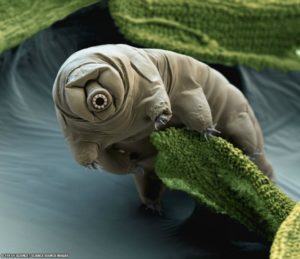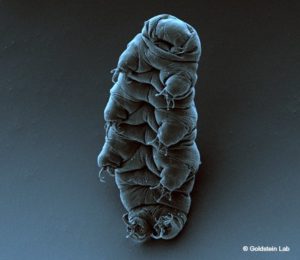 The tardigrade, a ubiquitous creature familiar to wastewater professionals, is enjoying a moment in the spotlight. New York’s American Museum of Natural History is showcasing them as part of the exhibition Life at The Limits: Stories of Amazing Species. The BBC calls them “the toughest animals on Earth,” citing their successful round trip to outer space, attached to a satellite. Neil deGrasse Tyson discussed them on an episode of Cosmos: A Spacetime Odyssey. They even have their own Pinterest board.
The tardigrade, a ubiquitous creature familiar to wastewater professionals, is enjoying a moment in the spotlight. New York’s American Museum of Natural History is showcasing them as part of the exhibition Life at The Limits: Stories of Amazing Species. The BBC calls them “the toughest animals on Earth,” citing their successful round trip to outer space, attached to a satellite. Neil deGrasse Tyson discussed them on an episode of Cosmos: A Spacetime Odyssey. They even have their own Pinterest board.
While the tardigrade is enjoying its newfound popularity, it seems like a good time to take a closer look at this fascinating, seemingly indestructible creature and its role in biological wastewater treatment.
A Bug’s Life
 The tardigrade, which takes its name from the Latin for “slow stepper,” is also called a water bear or moss piglet. First discovered in 1773, there are over 1,000 described species, although only a few are found in the wastewater environment. They are most commonly found in lichens and moss, although their only requirement is water, whether that water is at the ocean floor or the top of a mountain. They may be nature’s most durable creature, able to withstand temperatures as low at 450° F below zero and as high as 300°; radiation at hundreds of times the dose that would kill a human; and a trip to outer space and back.
The tardigrade, which takes its name from the Latin for “slow stepper,” is also called a water bear or moss piglet. First discovered in 1773, there are over 1,000 described species, although only a few are found in the wastewater environment. They are most commonly found in lichens and moss, although their only requirement is water, whether that water is at the ocean floor or the top of a mountain. They may be nature’s most durable creature, able to withstand temperatures as low at 450° F below zero and as high as 300°; radiation at hundreds of times the dose that would kill a human; and a trip to outer space and back.
A water bear has eight legs with claws and a gait that resembles a bear—hence the name. They generally range from 0.3–0.5 mm in length, or nearly visible with the naked eye. The tubular mouth has hard little stylets, which it uses to pierce its prey and suck the contents out. Its skin is transparent and often reflects the water bear’s environment or what it has eaten recently. One of the reasons it is so hardy is its ability to dehydrate itself into a state of hibernation, reversibly suspending its metabolism for ten years or longer.
The tardigrade is a metazoan organism, like nematodes, Daphnia, and bristle worms. Metazoa are on the food chain above algae and protozoa like amoeba, flagellates, and ciliates and feed on them; protozoa feed on very small and non flocculent bacteria and algae. In the simplest terms, bacteria do the grunt work in a wastewater treatment plant, consuming the soluble organic material like protein, carbohydrates, and fats, then forming as floc and settling out. Protozoa control the bacterial population and pathogens, cycle nutrients, and improve water clarity. Metazoa keep protozoa and bacterial populations in check; some process sludge. (For a more detailed explanation of wastewater microbiology, check out the Wisconsin Wastewater Association’s presentation, Wastewater Microbiology & Process Control, by Toni Glymph, an award-winning wastewater microbiologist and certified operator and the author of several books on the subject.)
Because tardigrades are so hardy and resistant to changes in temperature and food supply, it’s not entirely known what their function is in the wastewater ecosystem. However, they are useful in samples as an indicator of conditions: It is known that they are sensitive to ammonia, so if they show up in your sample, there is little to no ammonia present. They appreciate a long sludge age and can also indicate a low food to biomass ratio, high DO, and good BOD removal.
Water bears hate ammonia. So does the EPA. Learn how to cost-effectively remove ammonia from your wastewater lagoon.
Hopefully, all this attention to the tardigrade will lead to more useful research on its role in wastewater treatment. In the meantime, if you haven’t finished your Christmas shopping, this BuzzFeed article, 9 Adorable Water Bear Products You Didn’t Know Existed, may give you some gift ideas.


